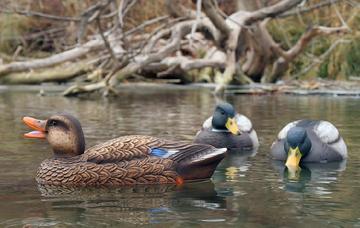Don Briddell
Designer
Don Briddell was born in 1944 in Crisfield, Maryland. He began his art career in the second grade selling drawings for classmates, one cent for a black and white and three cents for color—business doesn't get any more basic than that! Back then Crisfield was a community of watermen making their living off the resources of the Chesapeake Bay. Don’s parents and extended family owned the manufacturing firm, Charles D. Briddell, incorporated in 1925 by Don’s grandfather. Between 1930 and 1963 the family company was a significant employer of many of the town’s people, making metal ware for the fishing industry before the war, military knives and bazooka rockets during WWII and Carvel Hall cutlery after the war. The company was sold to Towel Silver in 1963.
At thirteen years old Don's parents allowed him to duck hunt on his own. To duck hunt you either “walked the marsh” in hopes of stumbling upon a duck, or needed decoys were used. One summer Don found a very old French musket in his grandmother's attic in Castleton, Vermont, dating from the French and Indian wars. Don swapped the musket, too worn-out to shoot, to Lloyd Tyler, a trader in working decoys, for a dozen equally worn-out decoys that had been made by locals, who were themselves long gone
Subject ID: 76257
MoreDon Briddell was born in 1944 in Crisfield, Maryland. He began his art career in the second grade selling drawings for classmates, one cent for a black and white and three cents for color—business doesn't get any more basic than that! Back then Crisfield was a community of watermen making their living off the resources of the Chesapeake Bay. Don’s parents and extended family owned the manufacturing firm, Charles D. Briddell, incorporated in 1925 by Don’s grandfather. Between 1930 and 1963 the family company was a significant employer of many of the town’s people, making metal ware for the fishing industry before the war, military knives and bazooka rockets during WWII and Carvel Hall cutlery after the war. The company was sold to Towel Silver in 1963.
At thirteen years old Don's parents allowed him to duck hunt on his own. To duck hunt you either “walked the marsh” in hopes of stumbling upon a duck, or needed decoys were used. One summer Don found a very old French musket in his grandmother's attic in Castleton, Vermont, dating from the French and Indian wars. Don swapped the musket, too worn-out to shoot, to Lloyd Tyler, a trader in working decoys, for a dozen equally worn-out decoys that had been made by locals, who were themselves long gone
Living in the “Downneck” section of Crisfield, a mile through the woods from Don’s home, were the world famous wildfowl carvers, Lem and Steve Ward. The Ward brothers began carving decoys in 1919, after Steve returned home from WWI, following the tradition of the region, which dated back to colonial times. In time, the Ward Brothers would become American icons, receiving the National Heritage Award, one of twelve given by President Ronald Reagan on behalf of the Smithsonian Institution. A decoy by the Wards that went for $1.50 in 1920, sold in recent years at auction for $95,000.
Subject ID: 76257
Subject ID: 76257
